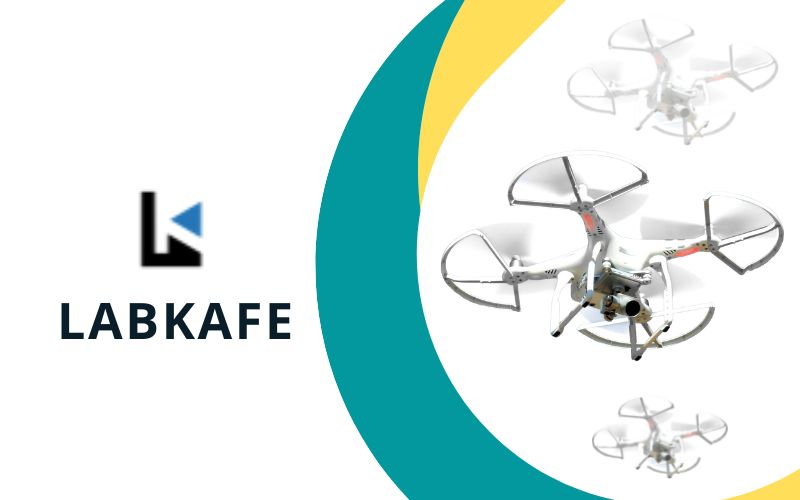It seems drones are everywhere these days. If you go to a scenic location, chances are good that you’ll hear that buzzing noise nearby soon. But one needs a dedicated place to develop and research about drones ‒ a drone lab, to be sure. Today, we will talk about how to set up a drone lab and what drone equipment you need.

About Drones
So, what are drones anyway? Drones, or to be more formal, UAVs (Unmanned Aerial Vehicles) are small aircraft that you can control from the ground with a dedicated controller. This is a very broad definition, though. There are a bewildering variety of drones that come in all shapes and sizes ‒ from tiny fits-in-the-palm toys to military remote controlled airplanes capable of bombing a whole village.
Drones are a very young technology, at least in the public sector. The concept of remote controlled aircraft is nothing new but in the consumer sector the revolution has just only begun. Nowadays, we are using drones for a lot of stuff ‒ from taking pictures and videos to analyzing large 3D spaces to counting trees and finding geographical faults.
Once they were a technology reserved for the elite and the special, but now drones have become accessible and affordable to pretty much anyone. This is pushing the boundaries of aircraft innovation like never before. You can say, community involvement in UAV research has taken to the skies!
Drone Lab in School
In our country, a change is coming over the educational landscape. The new education policy we are implementing requires schools to upgrade to 21-st century knowledge and skill set disbursement. With that in view we are implementing STEM labs in schools, and drone labs are an excellent way to teach STEM if you got the funds for it.
Teaching drone technology to students in a drone lab is a great way to introduce them to modern technology and engineering. Drones are a ton of fun ‒ kids will love building and maintaining them. They have lots of different parts which can be changed to alter the behavior of the drone; this will incite the students to explore and experiment on their own.
Drones are great at teaching how various physics principles work ‒ all that are connected to aerial movements and fluids. They are great at building fine control skills and visual coordination since you have to control them indirectly from the ground. Kids can also learn various aspects of society and how the modern and futuristic world works with drones. For example, drones are used to carry out pathological testing in rural and mountainous areas.
Let’s face it, drones are here to stay ‒ just as smartphones were 20 years ago. The faster we prepare our future generations for them, the better off they will be.
How to Start a Drone Lab
Doing R&D with drones is as exciting as it can be rewarding. But to do it effectively to gain results, you will need to set up a drone lab properly. That is not as easy as it sounds.
Most drone labs need to have at least two dedicated areas of work depending upon their function ‒ the development zone and the testing zone. Let’s look into details about these.
Drone Development Area
The room where students build, maintain, and modify their drones and drone parts is called the Drone Development Area. Since this science is very common to STEM, an existing STEM lab with a dedicated drone assembly/maintenance table will do fine as a drone development zone. If, however, you are building a solo or separate drone lab for your school, then you have to include the following furniture in it:
- Electronics station
- Soldering booth (can be integrated into the electronics station)
- Assembly and maintenance desk
- Drone gimbal rig (to test a drone’s stability)
- Storage cabinets (open and shuttered)
- Lab safety/emergency booth
Additionally, you will need the following drone lab equipment ready at hand:
- Drone frames: these make the ‘body’ of the drone and depending upon them you have to decide what kind of drone you will build. The frame of a drone affects its configuration entirely (like motor and propeller number), other mechanical components that you can attach, stability, flight speed and pretty much everything else about a drone.
- Drone Motors: these are the ‘engines’ of the drone. Drone motors directly drive the propellers which provide the thrust. They are generally small and lightweight BLDC (Brushless DC) motors which can achieve great speed with a small current. They are also polar ‒ you need to decide how many clockwise rotating motors you need and how many anticlockwise (hint: generally, they come in pairs) you need.
- ESCs: Electronic speed controllers are kind of the motion control nerve center for your rig. ESCs are high-precision lightweight electronic modules (generally packed solid) that directly control the speed and direction of the motors, so they team up to control how the drone will move.
- Propellers: How can a drone go airborne without thrust-providing propellers? These push the air down and create upwards force that lifts the drone up. They are generally made up of carbon fiber and epoxy. Like motors, they come in directional twists as well.
- Power Distribution Boards: No matter how much power is there, it won’t achieve anything until it is distributed properly among the components. Power distribution boards are in charge of that in drones.
- Connectors: This one is a no-brainer. You need wires to connect various parts of an electronic device, period. In a drone, the wires need to team up with specific joiners to create ‘connectors’. Take these in various colors so your students can identify what goes where.
- Lights: Consider adding tiny LED strobes to your drone in order to spot it from a distance, work with low light conditions, and spot drone direction.
- Batteries: Generally for school projects, 12-24 volts LiPo batteries will suffice.
- Battery Chargers: Goes without saying.
- Flight Controller: Virtually the brain of your drone, the flight controller uses various sensors (gyroscope, accelerometer, magnetometer, GPS etc.) to sense how the drone is moving, and uses that data to direct the ESCs to control the drone’s flight.
- RC Receiver: A remote control receiver or drone radio transmitter is your main control device for your drone. This handheld device has various controls that you can use to direct your drone. The device translates your finger movements into electronic signals that it transmits to the drone. Some controllers have receivers that can get signals from the drone as well, like video data from drone cameras.
- Anti-vibration Pad: These small styrofoam padding sits between various joints in the drone and reduces the vibration from the motors, protecting the sensors.
- Camera Mount: If your drone is large and strong enough, it can carry a small camera on its underbelly. The camera mount provides the place to attach your GoPro or similar cams.
- Micro SD Card: If your drone has built-in cameras then you’ll need small storage solutions like micro SD cards.
- Drone Landing Pads: Don’t land your expensive drone in the dust! Get a proper landing pad and land it there.
- Propeller Guards: When drones get hit by an obstacle, the first thing to go is the propeller since they are the most extended parts of a drone. Protect your expensive equipment, invest in propeller guards.
Drone Carrying Case: For outdoor use, you will have to provide proper casings and backpack or handheld carrying bag for the drone, its controller, and accessories.
Apart from the above, do keep some basic DIY crafting supplies like glue, tapes, cardboard, paint, etc. handy in a cabinet ‒ you never know what kids may think up!
Drone Testing Area
What’s the point of building a cool drone if you can’t fly it around and make it do things? The drone testing area is a dedicated space for the students to test out their drones in a safe, clear area with various testing accessories installed. It can be indoor or outdoor, depending upon your facility’s available space.
An ideal drone testing area should be 18 feet by 24 feet in floor space and 15 feet of vertical clearance. Indoors, you can throw up a net inside your gym or indoor performance area and use that for your drone testing. The net should be at most 1-inch square mesh. Cover the floor of this area with foam matting so the delicate devices don’t get hurt when they drop from mid-air.
Note: you can also rig up a net in an outdoor area for drone testing purposes. This will ensure drones stay within range and don’t fly off.
If you are testing outdoors, consider equipping your students with high-visibility work vests (yellow or orange) so that people don’t jostle them accidentally while they are holding delicate equipment and working. If they are going to work inside the testing area, then equip them with hard hats as well ‒ its not a pleasant experience when a flying drone hits you on the back of your head.
If the drone testing area is indoors and permanent, then you can invest in some good hardware for drone flight testing. Hang loops and bars and rods from the ceiling to create an obstacle course. Add motion-detection cameras in four corners to track your drone’s performance precisely. Use glass instead of net. Project location photos on a wall and test to see if the drone recognizes obstacles. There are lots of possibilities you can explore with an indoor drone testing facility.
On the other hand, the outdoors offer you lots of opportunities if your drone will be primarily used for filming or transportation.
Take Off Now
Drones are fun, educational, useful, and certainly the future that’s going to stay. Building a drone lab for your students now is one of the smartest things to do to increase your school reputation and attract more students. Building a standalone drone lab or as a part of the STEM lab is very prudent ‒ albeit a bit costly ‒ for any school administrator. To that end, Labkafe can help immensely. Our drone lab package includes all lab equipment and accessories you need to take off with your drone lab today. Contact now and find out more!












Leave a Reply